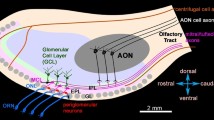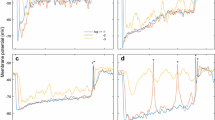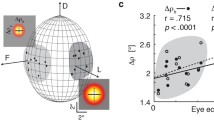Summary
The gross morphology and the fine-structural characteristics of neurones of the second and third optic ganglia of the honeybee Apis mellifera were investigated light microscopically on the basis of Golgi (selective silver)- and reduced silver preparations.
The second optic ganglion, the medulla, is ovoid in shape and has a slightly convex distal surface and a slightly concave proximal surface. The medullar outer levels are characteristically composed of neuronal arrangements showing strict precision of their geometrical spacing proximally as far as a pronounced layer of tangential fibre elements comprising the serpentine layer of the medulla. At the inner medullary levels retinotopic channels are again multiplied, and the arrangement of axons and dendrites contribute to a complex lattice.
The third optic ganglion, the lobula, is interposed between the medulla and the protocerebrum. It is the site of termination of the third-order neurones. The lobula in hymenopterans appears, in contrast to dipterans, odonates and lepidopterans, as a single neuropilic mass.
A short review of the electrophysiological data concerning these two ganglia has been tentatively correlated with some of the anatomical data.
Similar content being viewed by others
References
Boschek CB (1971). On the fine structure of the peripheral retina and the lamina of the fly. Musca domestica. Z Zellforsch 110:336–349
Braitenberg V (1967). Patterns of projection in the visual system of the fly. I. Retina-lamina projections. Exp Brain Res. 3:271–298
Braitenberg V (1970) Ordnung und Orientierung der Elemente im Sehsystem der Fliege. Kybernetik 7:235–242
Braitenberg V, Strausfeld NJ (1973). Principles of the mosaic organization in the visual systems neuropil of Musca domestica L. In: Jung R (ed) Handbook of sensory physiology. Vol. VII/3A: Central processing of visual information. Springer, Berlin Heidelberg New York
Cajal SR (1909) Nota sobre la estructura de la mosca (M. vomitoria L.). Trab Lab Invest Biol Univ Madrid 7:217–257
Cajal SR, Sanchez D (1915) Contribucion al conocimiento de los centros nerviosos de los insectes. Trab Lab Invest Biol Univ Madrid 13:1–168
Campos-Ortega JA, Strausfeld NJ (1972) The columnar organization of the second synaptic region of the visual system of Musca domestica L. I. Receptor terminals in the medulla. Z Zellforsch 124:561–585
Campos-Ortega JA, Strausfeld NJ (1973) Synaptic connections of intrinsic cells and basket arborisations in the external plexiform layer of the fly's eye. Brain Res 59:119–136
Chi C, Carlson SD (1976) Close apposition of receptor cell axons in the housefly, Musca domestica. Cell Tissue Res 167:537–545
Chi C, Carlson SD (1980) Membrane specializations in the first optic neuropil of the housefly Musca domestica L. II. Junctions between neurons. J Neurocytol 9:429–449
Ciaccio MG (1976) L'oeil des Dipteres. J Zool (Paris) 5:313–319
De Voe RD (1980) Movement sensitive cells in the fly's medulla. J Comp Physiol 138:93–119
Dvorak DR, Bishop LG, Eckert HE (1975) On the identification of movement detectors in the fly optic lobe. J Comp Physiol 100:5–23
Eckert HE (1978) Response properties of dipteran giant visual interneurons involved in control of optomotor behaviour. Nature 271:358–360
Eckert H (1980) Functional properties of the H1-neurone in the third optic ganglion of the blow fly, Phaenicia. J Comp Physiol 135:29–39
Eckert H, Bishop LG (1978) Anatomical and physiological properties of the vertical cells in the third optic ganglion of Phaenicia sericata (Diptera, Calliphoridae). J Comp Physiol 126:57–86
Hanström B (1928) Vergleichende Anatomie des Nervensystems der wirbellosen Tiere. Springer, Berlin
Hausen K (1976a) Struktur, Funktion und Konnektivität bewegungsempfindlicher Interneurone im dritten optischen Neuropil der Schmeißfliege Calliphora erythrocephala. Doctoral Dissertation. University of Tübingen
Hausen K (1976b) Functional characterization and anatomical identification of motion sensitive neurons in the lobula plate of the blowfly Calliphora erythrocephala. Z Naturforsch 31c:629–633
Hertel H (1980) Chromatic properties of identified interneurons in the optic lobes of the bee. J Comp Physiol 137:215–231
Hickson SJ (1885) The eye and optic tract of insects. Quart J Micr Sci 2, Band XXV
Kenyon FG (1896). The brain of the bee. A preliminary contribution to the morphology of the nervous system of the arthropoda. J Comp Neurol 6:133–210
Kenyon FG (1897) The optic lobes of the bee's brain in the light of recent neurological methods. Am Nat 31:369–376
Kien J, Menzel R (1977a) Chromatic properties of interneurons in the optic lobes of the bee. I. Broad band neurons. J Comp Physiol 113:17–34
Kien J, Menzel R (1977b). Chromatic properties of interneurons in the optic lobes of the bee. II. Narrow band and colour opponent neurons. J Comp Physiol 113:35–53
Leydig F (1885) Zum feineren Bau der Arthropoden. Arch Anat Physiol
Melamed J, Trujillo-Cenoz O (1968) The fine structure of the central cell in the ommatidia of Dipterans. J Ultrastruct Res 21:313–334
Mimura K (1971) Movement discription by the visual system of flies. Z vergl Physiol 73:105–138
Pierantoni R (1976) A look into the cockpit of the fly. The architecture of the lobula plate. Cell Tissue Res 171:101–122
Ribi WA (1974) Neurons in the first synaptic region of the bee, Apis mellifera. Cell Tissue Res 148:277–286
Ribi WA (1975a). The neurons of the first optic ganglion of the bee, Apis mellifera. Advances in Anatomy 50:1–43
Ribi WA (1975b). The organization of the lamina ganglionaris of the bee. Z Naturforsch 30c:851–852
Ribi WA (1975c). The first optic ganglion of the bee. I. Correlation between visual cell types and their terminals in the lamina and medulla. Cell Tissue Res. 165:103–111
Ribi WA (1976). The first optic ganglion of the bee. II. Topographical relationships of second order neurons within a cartridge and to groups of cartridges. Cell Tissue Res. 171:359–373
Ribi WA (1978) Gap junctions coupling photoreceptor axons in the first optic ganglion of the fly. Cell Tissue Res. 195:299–308
Ribi WA (1979) The first optic ganglion of the bee. III. Regional comparison of photoreceptor cell axon morphology. Cell Tissue Res 200:345–357
Ribi WA (1981) The first optic ganglion of the bee. IV. Synaptology of receptor cell axons and first order interneurons (a Golgi-EM study). Cell Tissue Res 215:443–464
Riehle A (1980) Reaktionsmuster zentraler visueller Interneurone der Honigbiene (Apis mellifera) auf hetero-chromatisches Flickerlicht. Dissertation, FB23 der Freien Universität Berlin
Sommer EW, Wehner R, (1975). The retina lamina projection in the visual system of the bee, Apis mellifera. Cell Tissue Res 163:45–61
Strausfeld NJ (1970a). Golgi studies on insects. Part II. The optic lobes of diptera. Phil Trans Soc B 258:175–223
Strausfeld NJ (1970b). Variations and invariants of cell arrangements in the visual system and corpora ped. Verb Zool Ges 64:97–108
Strausfeld NJ (1971a). The organization of the insect visual system (light microscopy). I. Projections and arrangements of neurons in the lamina ganglionaris of diptera. Z Zellforsch 121:377–441
Strausfeld NJ (1971b). The organization of the insect visual system (light microscopy). II. The projection of fibres across the first optic chiasma. Z Zellforsch 121:442–454
Strausfeld NJ (1976a). Mosaic organizations, layers, and visual pathways in the insect brain. In: Zettler F, Weiler R (eds) Neural principles in vision. Springer, Berlin Heidelberg New York, pp 245–279
Strausfeld NJ (1976b) Atlas of an insect brain. Springer, Berlin Heidelberg New York
Strausfeld NJ, Braitenberg V (1970) The compound eye of the fly (Musca domestica): connections between the cartridges of the lamina ganglionaris. Z Vergl Physiol 70:95–104
Strausfeld NJ, Nässle DR (1980) Neuroarchitecture of brain regions that subserve the compound eyes of crustacean and insects. In: Autrum H (ed) Handbook of sensory physiology, Vol. VII/6B: Comparative physiology and evolution of vision in invertebrates. Springer, Berlin Heidelberg New York
Trujillo-Cenoz O (1965) Some aspects of the structural organization of the intermediate retina of dipterans. J Ultrastruct Res 13:1–23
Varela FG (1970) Fine structure of the visual system of the honey bee (Apis mellifera). II. The lamina. J Ultrastruct Res 31:178–194
Author information
Authors and Affiliations
Rights and permissions
About this article
Cite this article
Ribi, W.A., Scheel, M. The second and third optic ganglia of the worker bee. Cell Tissue Res. 221, 17–43 (1981). https://doi.org/10.1007/BF00216567
Accepted:
Issue Date:
DOI: https://doi.org/10.1007/BF00216567




